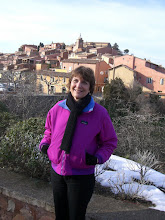 We’re not morbid individuals; really, we aren’t. Visiting a Parisian cemetery is like walking around in a beautiful park, only one where there are tombstones! The main inner-city graveyards in the French capital are lined with trees and flowers and have substantial collections of art works by famous sculptors. When we took a tour of le cimetière de l’Est, better known as Père Lachaise, last Saturday, our guide said that it’s like un musée en plein air, an outdoor museum. And that’s exactly it. Named after the priest who was the confessor of le roi Louis XIV, this cemetery in Paris’s 20e arrondissement is reputed to be the most visited in the world, attracting over one hundred thousand people per year.
We’re not morbid individuals; really, we aren’t. Visiting a Parisian cemetery is like walking around in a beautiful park, only one where there are tombstones! The main inner-city graveyards in the French capital are lined with trees and flowers and have substantial collections of art works by famous sculptors. When we took a tour of le cimetière de l’Est, better known as Père Lachaise, last Saturday, our guide said that it’s like un musée en plein air, an outdoor museum. And that’s exactly it. Named after the priest who was the confessor of le roi Louis XIV, this cemetery in Paris’s 20e arrondissement is reputed to be the most visited in the world, attracting over one hundred thousand people per year. The guide explained to our group that the 119 acres of land originally belonged to the Catholic Church but that it was purchased by the state in the early nineteenth century under the reign of Napoléon Bonaparte. In order to make the immense but somewhat
 remote memorial park more appealing to Parisians, the government had the supposed remains of famous people transferred to the location. Visitors can, for example, see the graves of celebrated medieval lovers Héloïse and Abélard, and seventeenth century writers Molière and La Fontaine. The graveyard has become so popular that now families can only “rent” spaces for thirty to fifty years, but the time can be extended...for a fee, of course.
remote memorial park more appealing to Parisians, the government had the supposed remains of famous people transferred to the location. Visitors can, for example, see the graves of celebrated medieval lovers Héloïse and Abélard, and seventeenth century writers Molière and La Fontaine. The graveyard has become so popular that now families can only “rent” spaces for thirty to fifty years, but the time can be extended...for a fee, of course. Before the tour started, we were fortunate enough to be sitting on a bench when a photographer came up to take a picture of a tombstone near us. He told us that he
 had a collection of over a thousand different photos of bustes, médaillons, statues, and stèles ("gravestones") from the various cemeteries around Paris. There is, for example, a Rodin sculpture of Belgian composer César Franck in le cimetière Montparnasse. Yet, he explained, there are no Rodins in Père Lachaise; the famous bust of the author Balzac was done by someone else. He suggested that we visit a nearby marble medallion by Auguste Préault which he was particularly fond of called Le Silence.
had a collection of over a thousand different photos of bustes, médaillons, statues, and stèles ("gravestones") from the various cemeteries around Paris. There is, for example, a Rodin sculpture of Belgian composer César Franck in le cimetière Montparnasse. Yet, he explained, there are no Rodins in Père Lachaise; the famous bust of the author Balzac was done by someone else. He suggested that we visit a nearby marble medallion by Auguste Préault which he was particularly fond of called Le Silence.Naturally, many tourists come to pay their respects to some of the international celebrities of the past two centuries, from German painter Max Ernst to Irish writer
 Oscar Wilde. Americans are well represented: authors Richard Wright, Gertrude Stein and Alice B. Toklas, soprano Maria Callas, dancer Isadora Duncan, and The Doors rocker Jim Morrison to mention but a few. For those interested in classical music, there are monuments to both Chopin and Rossini, though the latter’s grave is a cenotaphe moderne, simply a monument since his remains now lie in his native Italy. The tombs of French singers Édith Piaf, Gilbert Bécaud, and actors Sarah Bernhardt, Yves Montand and Simone Signoret can be found at the cemetery. The guide pointed out that Mother Nature, aided by modern day pollution, plays havoc with the monuments; moss grows on the stones and tree roots upset them. But it is still a beautiful place to visit.
Oscar Wilde. Americans are well represented: authors Richard Wright, Gertrude Stein and Alice B. Toklas, soprano Maria Callas, dancer Isadora Duncan, and The Doors rocker Jim Morrison to mention but a few. For those interested in classical music, there are monuments to both Chopin and Rossini, though the latter’s grave is a cenotaphe moderne, simply a monument since his remains now lie in his native Italy. The tombs of French singers Édith Piaf, Gilbert Bécaud, and actors Sarah Bernhardt, Yves Montand and Simone Signoret can be found at the cemetery. The guide pointed out that Mother Nature, aided by modern day pollution, plays havoc with the monuments; moss grows on the stones and tree roots upset them. But it is still a beautiful place to visit.

No comments:
Post a Comment